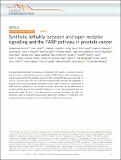Synthetic lethality between androgen receptor signalling and the PARP pathway in prostate cancer
Abstract
Emerging data demonstrate homologous recombination (HR) defects in castration-resistant prostate cancers, rendering these tumours sensitive to PARP inhibition. Here we demonstrate a direct requirement for the androgen receptor (AR) to maintain HR gene expression and HR activity in prostate cancer. We show that PARP-mediated repair pathways are upregulated in prostate cancer following androgen-deprivation therapy (ADT). Furthermore, upregulation of PARP activity is essential for the survival of prostate cancer cells and we demonstrate a synthetic lethality between ADT and PARP inhibition in vivo. Our data suggest that ADT can functionally impair HR prior to the development of castration resistance and that, this potentially could be exploited therapeutically using PARP inhibitors in combination with androgen-deprivation therapy upfront in advanced or high-risk prostate cancer.Tumours with homologous recombination (HR) defects become sensitive to PARPi. Here, the authors show that androgen receptor (AR) regulates HR and AR inhibition activates the PARP pathway in vivo, thus inhibition of both AR and PARP is required for effective treatment of high risk prostate cancer.
Citation
Asim , M , Tarish , F , Zecchini , H I , Sanjiv , K , Gelali , E , Massie , C E , Baridi , A , Warren , A Y , Zhao , W , Ogris , C , McDuffus , L-A , Mascalchi , P , Shaw , G , Dev , H , Wadhwa , K , Wijnhoven , P , Forment , J V , Lyons , S R , Lynch , A G , O'Neill , C , Zecchini , V R , Rennie , P S , Baniahmad , A , Tavaré , S , Mills , I G , Galanty , Y , Crosetto , N , Schultz , N , Neal , D & Helleday , T 2017 , ' Synthetic lethality between androgen receptor signalling and the PARP pathway in prostate cancer ' , Nature Communications , vol. 8 , 374 . https://doi.org/10.1038/s41467-017-00393-y
Publication
Nature Communications
Status
Peer reviewed
ISSN
2041-1723Type
Journal article
Description
This study was supported by the National Cancer Research Institute (National Institute of Health Research (NIHR) Collaborative Study: ‘Prostate Cancer: Mechanisms of Progression and Treatment (PROMPT)” (grant G0500966/75466). This work was funded by a Cancer Research UK program grant (D.N.), the Swedish Research Council (T.H.), AFA insurance (T.H.), Swedish Cancer Society (T.H.), the Swedish Pain Relief Foundation (T.H.), the Torsten and Ragnar Söderberg Foundation (T.H.), AstraZeneca (T.H.) Centre for Clinical Research (CKF) (F.T.), the Västmanland Research Foundation for Cancer in Vasteras (F.T.), the Henning and Ida Persson Research Foundation (F.T.).Collections
Items in the St Andrews Research Repository are protected by copyright, with all rights reserved, unless otherwise indicated.

